Why The Navy Is Looking To End Carrier Qualifications Entirely For Its Pilots In Training
December 22, 2020
The Navy wants to overhaul how it trains its pilots due to recent innovations that have hit the fleet and the prospect of a new jet trainer.
The U.S. Navy is looking at ways that a new jet trainer aircraft could help the service to completely overhaul the way it trains its aviators. The planned successor to the current Boeing T-45 Goshawk could be employed across a number of roles in naval aviation — not just training brand new pilots. But above all else, top Navy officers are looking at how the aircraft could facilitate a totally new approach to the way it trains tactical jet pilots.
Speaking in November, Rear Admiral Gregory “Hyfi” Harris, the Director of the Air Warfare Division within the Office of the Chief of Naval Operations, said the service is talking to industry regarding the potential for a new training aircraft to grow into a multi-role platform as a future adversary, and potentially as a surrogate training aircraft — a move designed to reduce flight hours on expensive-to-operate front line fleet fighter aircraft. Separately, The War Zone understands that the same aircraft could also herald more even significant changes to the Navy’s training pipeline than were previously known. In fact, the advent of the new trainer could result in Naval Aviators tackling their very first flight to the aircraft carrier in a front line strike fighter, after they have already earned their coveted ‘wings of gold.’

An F/A-18F from Fleet Replacement Squadron VFA-106 undertakes carrier qualifications.
While this sounds like a ludicrous break in deeply established and proven methodology that would outrage naval aviators old and new, based on our investigation, this isn’t entirely the case. New technologies and a number of other factors have made such a proposed change not just possible, but probable. Still, there is bound to be major controversy surrounding such a move, especially considering the deeply ingrained aviator-focused culture within the Navy’s air arm.
A new training aircraft
In May 2020, the Navy launched its Undergraduate Jet Training System (UJTS) effort, which is ultimately intended to acquire a replacement for the T-45C Goshawk that is currently used in the advanced pilot training role, including the demanding regime of carrier flight operations instruction. A request for information (RFI) was released to industry on May 14, with a view to acquiring a non-developmental, land-based jet trainer by 2028.
The RFI said that rather than being able to land and take-off from the carrier like the current Goshawk and its predecessors, such as the TA-4J Skyhawk, the new trainer would be limited to conducting Field Carrier Landing Practice (FCLP) and shipboard touch-and-go landings. You can read more about the training aircraft program RFI in this past War Zone piece. However, the program is already evolving and The War Zone understands that the Navy is no longer even pursuing the touch-and-go requirement.
In fact, it is understood that the Navy is evaluating the potential implementation of one of the most dramatic changes ever in the way it trains new pilots in the complex art of big deck carrier operations with their associated arresting gear and catapults. Recent advances in technology mean that the Navy’s whole approach to operations from the aircraft carrier could be changing like never before.

A T-45C Goshawk is prepared to launch, while another performs a touch-and-go aboard an aircraft carrier.
A new approach
Until now, U.S. Naval Aviators have been required to fly manual approaches to aircraft carriers, requiring uncompromising levels of skill and competence, with little margin for error. This requires skilled throttle and control column inputs to nurse an aircraft down onto the deck with precision in order to catch one of the arresting wires.
However, the advent of new flight control software has almost done away with the need to wrestle an unforgiving carrier-borne aircraft onto a narrow flight deck. So-called Delta Flight Path (DFP) technology was conceived to help make the F-35C Lightning II far easier to land on an aircraft carrier, even with a pitching and rolling deck. It led to a spin-off program for the F/A-18E/F Super Hornet and EA-18G Growler that is known as Magic Carpet, or PLM — Precision Landing Mode. This too features enhanced flight control logic that is designed to make the carrier landing easier and more predictable for the pilot.
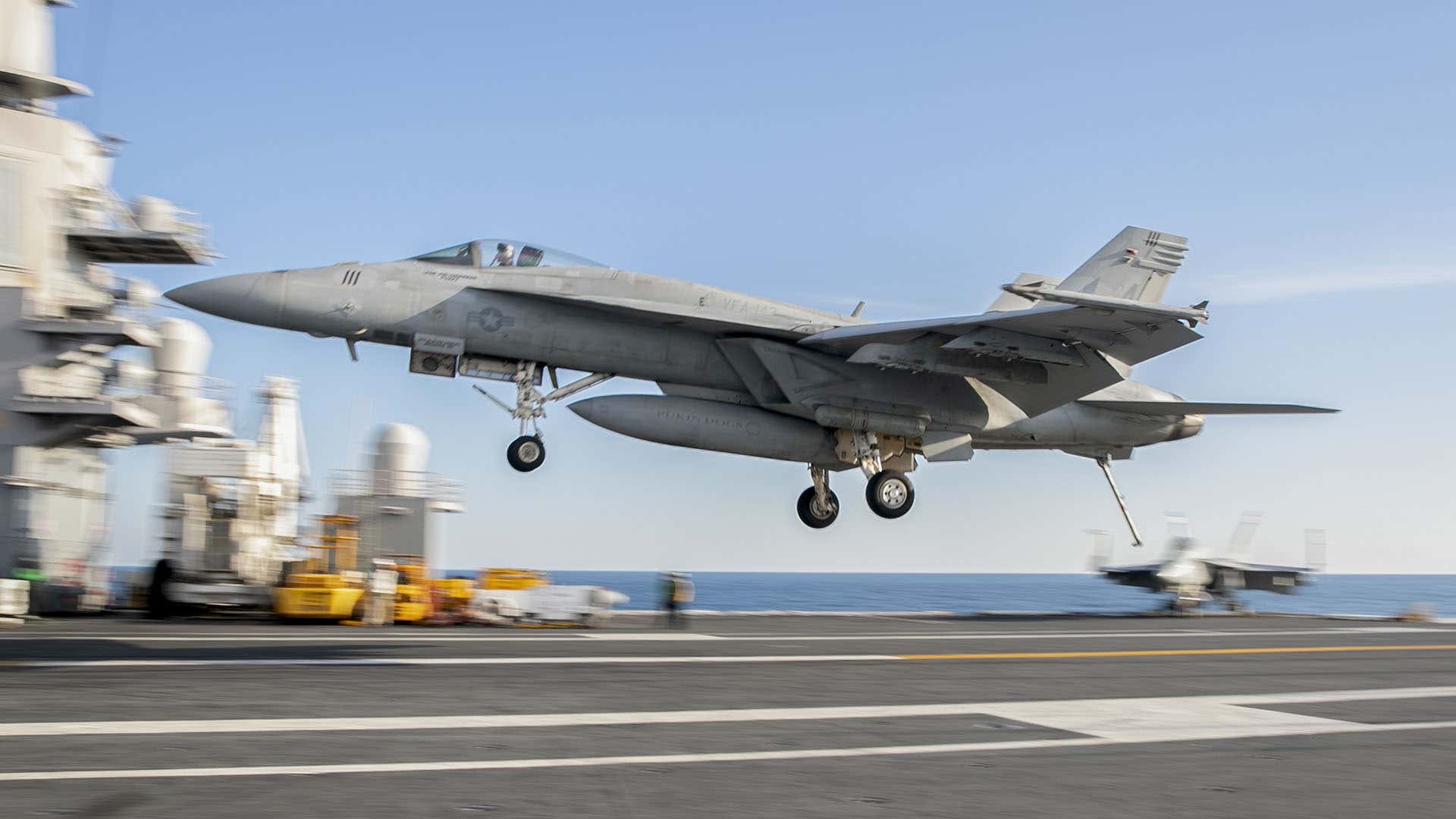
An F/A-18E from VFA-143 about to touch down on an aircraft carrier.
In the case of the Super Hornet, PLM is a mode within the autopilot to enable a much smoother profile on the glideslope, all the way to touchdown. From a piloting perspective, it means a dramatic reduction in control inputs. The resulting effect is a lot more “passes” (successful arrested landings) that are safe and consistent.
Data shows that the boarding rate across air wings has gone up significantly since PLM was introduced. As a result, pure manual flying around the carrier has become far less frequent for strike fighter aviators.
This technology works by Super Hornet and Growler pilots engaging PLM as an autopilot mode and they then fly to a ship-referenced velocity-vector that is projected on the heads-up display (HUD) in the cockpit. A different command logic is also activated within the aircraft’s flight control system, which is translated to the aircraft’s control surfaces. In effect, the Super Hornet or Growler gains direct lift control via modulating its flaps, which can fine-tune the decent onto the carrier’s landing area.
When using the system, the pilots still reference the traditional “Ball” on the carrier deck, and use stick inputs to make sure the aircraft is centered, but the jet will fly to the point on the deck where the velocity-vector is pointed, with the ship-referenced PLM accounting for wind, the fact that the ship is moving, and other factors.
Studies showed that Super Hornet pilots who were flying manually made as many as 300 course corrections in the final 18 seconds of their landing approach to the carrier. With Magic Carpet, even new pilots with no experience had cut that down to around 20 corrections.
In addition to the new flight control software, Navy aircraft can make use of the Instrument Carrier Landing System (ICLS) and the Automatic Carrier Landing System (ACLS) to aid safe recoveries, especially in inclement weather. ACLS uses a dedicated radar on the carrier to provide course correction information, but it reportedly lacks the precision necessary to work by itself in all situations. Indeed, many ACLS-assisted recoveries see the pilot still needing to take control and make the final adjustments before landing. The replacement Joint Precision Approach and Landing Systems (JPALS) uses GPS-enabled position information, and it was first delivered to an operational ship in April 2020. You can read more about these systems in this previous War Zone piece.
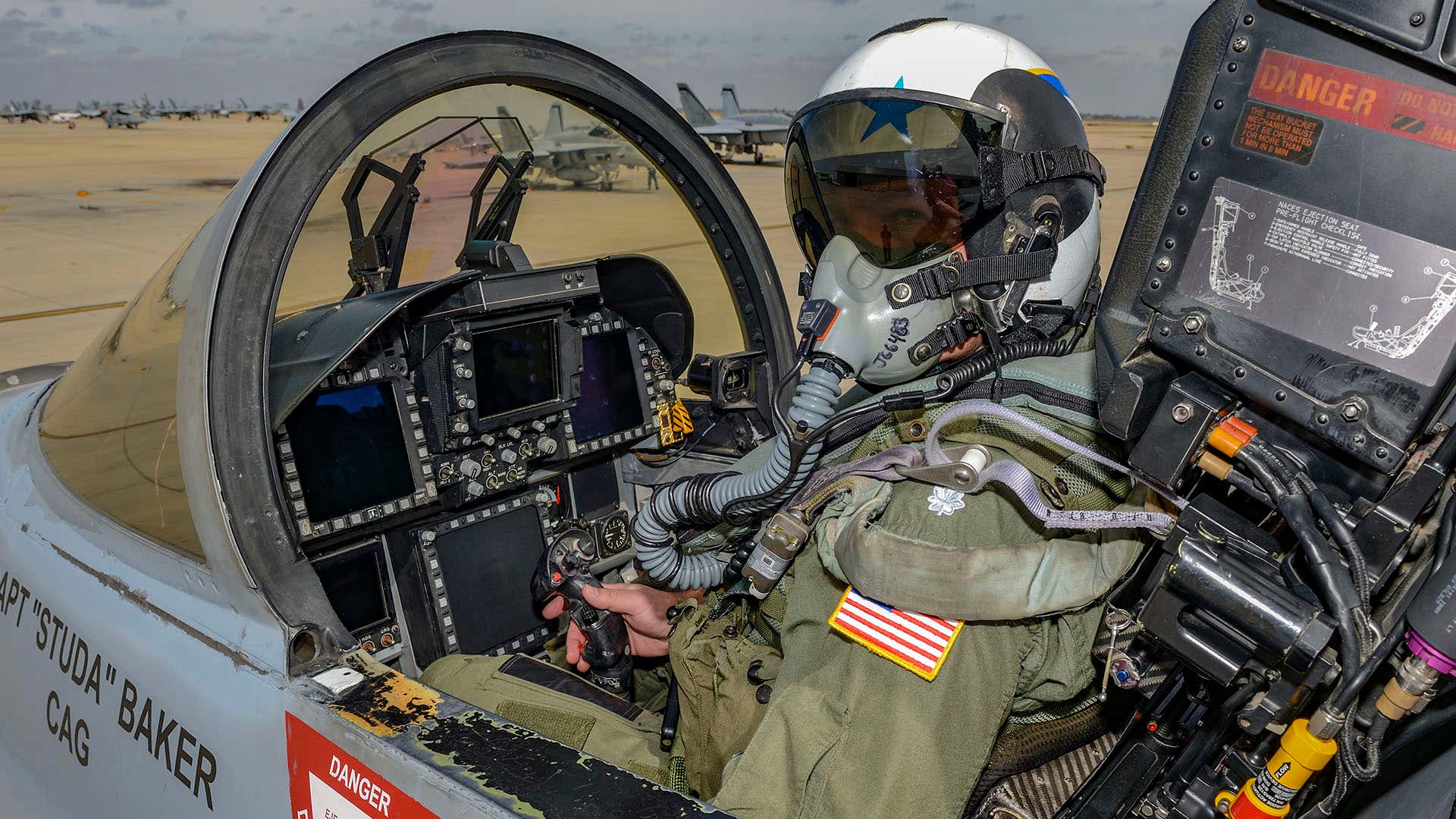
A pilot in the cockpit of an F/A-18E.
A revolution in carrier aviation
The addition of this automation has revolutionized the way in which the Navy’s modern strike fighters operate from the carrier deck. The resulting effect is that training pilots in the fine art of cat-and-trap carrier operations, and re-certifying fleet pilots during carrier qualifications (CQ), is able to be dramatically simplified with the use of technology.
The Navy’s two Super Hornet Fleet Replacement Squadrons (FRS) are already carrier qualifying (CQing) new pilots coming to the “Rhino” using PLM, without the need for them to fly manual passes. It marks a seismic change in the overall approach to the training of both new and experienced pilots around the “boat.” It also means that the Navy will no longer place such high emphasis on ingraining the style of manual flying throughout carrier pilot training.
New Naval Aviators destined for carrier operations currently begin their training journey in the T-6 Texan II, before moving to the T-45 Goshawk. It is in this aircraft that they will, from day one, fly in a way that prepares them for carrier ops — their ultimate goal.
Currently, new pilots who are destined for carrier-borne types are required to fly a series of FCLPs at the culmination of nearly every training mission. This involves them using a marked out carrier deck on the airfield’s runway and flying a circuit pattern and descent rate and speed that is consistent with how it would be flown for real at the boat. This is designed as part of the building block process towards their initial carrier qualifications in the T-45. This approach to training makes for a prolonged course due to the emphasis on carrier-minded flying from the outset — Goshawk students rarely fly a standard straight-in approach.
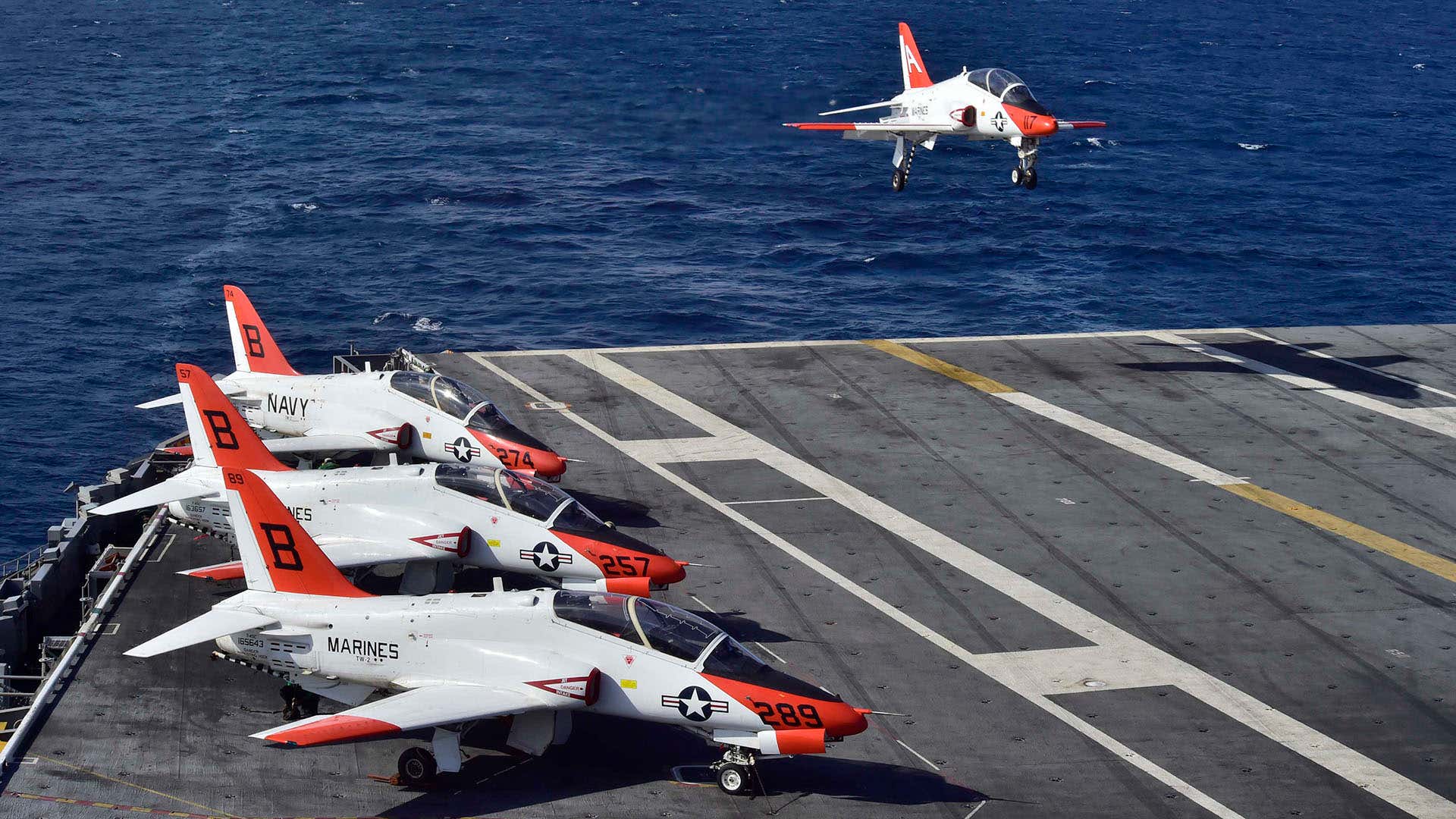
T-45s conduct training aboard the USS Dwight D. Eisenhower.
Notably, the Goshawk is regarded as being the current inventory’s most challenging jet to fly behind the carrier. This is now even more pronounced due to the new landing aids in the Super Hornet, Growler, and Lightning II, a luxury the T-45 does not possess.
Based on the land-based British Aerospace Hawk jet trainer, the T-45, which was introduced in 1991, was never conceived with the requisite handling characteristics to make carrier approaches easier for the pilot, unlike bespoke carrier aircraft such as the Super Hornet. The T-45 is described by aviators as being underpowered and twitchy during the final approach to the deck — though this certainly helps forge skilled hands.
The advent of technology such as PLM is guiding the Navy towards one of its biggest potential changes in the way it trains new pilots. It is evaluating whether to completely remove carrier qualifications from the advanced pilot training syllabus, and would therefore not require any carrier flying from its follow-on UJTS training aircraft. Strike fighter pilots could instead get their first taste of carrier flying once at their respective Fleet Replacement Squadron (FRS).

The pilot of an F/A-18E of training squadron VFA-122 about to launch from an aircraft carrier.
This is partly driven by the need to reduce training timelines and increase pilot production. The Navy is woefully short of pilots and, as a happy coincidence, it is now able to safely embrace new technology to enable it to simplify training for its new carrier aviators. A new training aircraft that goes hand-in-hand with the greatly increased use of high fidelity flight simulators, combined with front-line strike fighter aircraft that are now far less challenging to land on the carrier, are set to serve as a catalyst that allows the Navy to transform long-held training procedures.
Removing the carrier qualification element from the advanced jet training phase — not even touch-and-go landings — would also eliminate the need to heavily modify the UJTS aircraft to be carrier-capable, allowing for the procurement of a more straightforward off-the-shelf solution. Indeed, the advanced technology embedded in modern jet training aircraft will likely present a far more rounded solution to training new carrier pilots that makes significant use of simulators. The flight control software in the new trainer could even include a system that is similar to DFP or PLM, presenting a much more intuitive transition for pilots between the training squadron and the FRS.
In the past, new carrier aviators would not receive their coveted ‘wings of gold’ until they had completed carrier qualifications aboard an aircraft carrier in the T-45. However, the Navy could decide that new aviators receive their wings before they have ever flown from the ship. For EA-18G, F/A-18E/F, and F-35C pilots, their first taste of carrier flying would now come in the cockpits of their selected front line type.
Not only will this reduce training timelines, but it will also massively reduce the burden on the already over-tasked aircraft carriers — with zero requirements for them to sail especially in order to support CNATRA (Chief of Naval Air Training) activities. The Navy no longer enjoys the luxury of having a dedicated training carrier and must request the use of operational fleet ships when they are available. The number of carriers in the fleet in total could also be further reduced in the coming years, making such a constant burden all that much more of a challenge to handle.
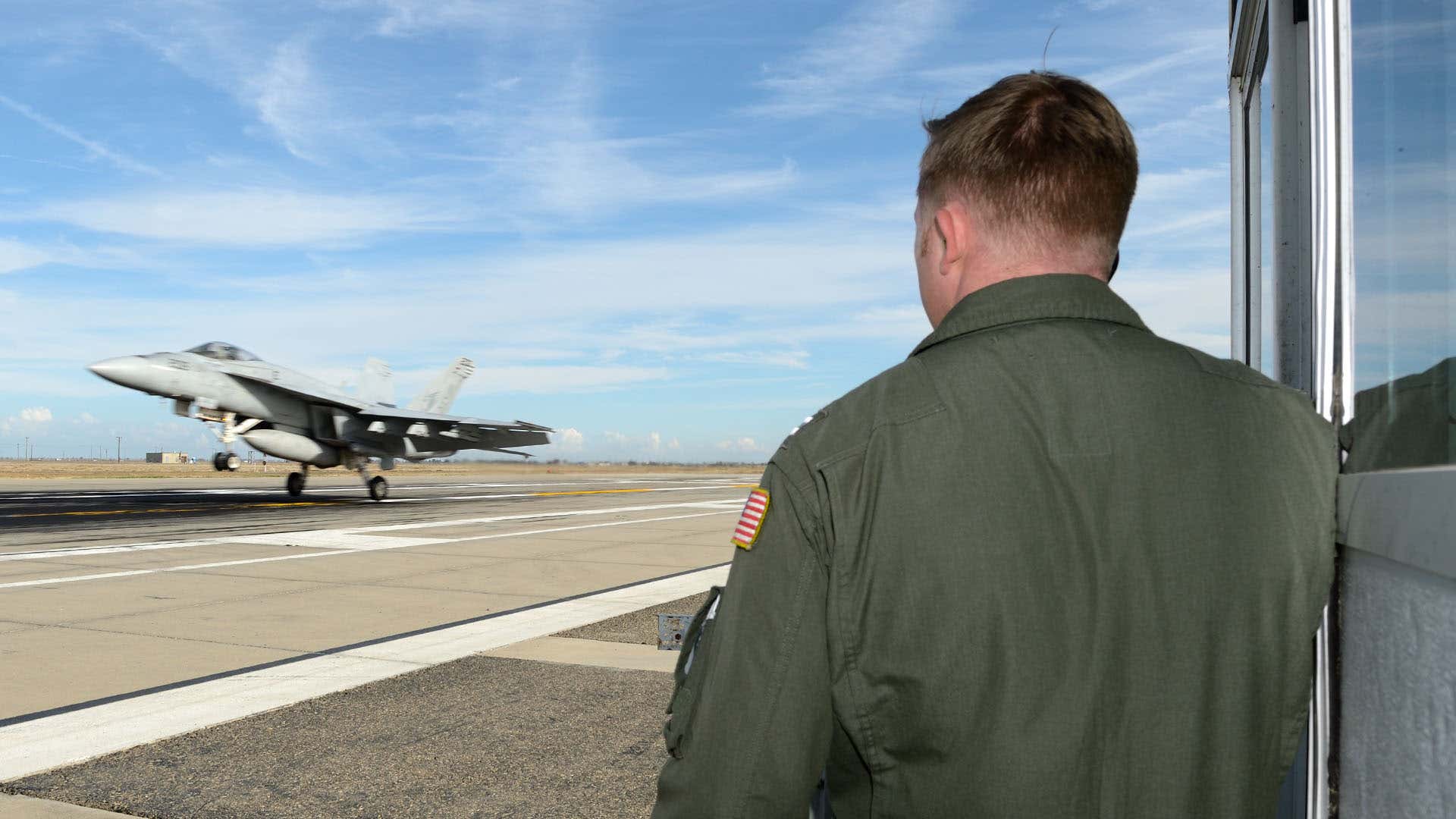
A Landing Signals Officer (LSO) monitors FCLPs at NAS Lemoore.
Air wing changes reflected in training plans
In its RFI for the new trainer, the Navy said each UJTS aircraft would be required to fly 400 hours each year. The jets would conduct around 1,200 FCLP landings using simulated carrier decks ashore, as well as up to 45 touch-and-gos on actual carriers, annually. This model would be dramatically reduced if the new approach is adopted. In fact, such is the need for change, the Navy is said to be already evaluating removing CQ from its current T-45 syllabus.
This also reflects a slightly reduced demand for complex cat-and-trap training due to the changing composition of the carrier air wing (CVW). The C-2 Greyhound Carrier Onboard Delivery (COD) aircraft is being replaced by the CMV-22 Osprey — meaning one less type to include in this style of training. The Osprey lands on a carrier like a helicopter, versus the Greyhound, which relies on the arresting gear to land and the catapult to launch.
Training new E-2 Hawkeye pilots presents a challenge to the Navy as these aircraft are required to be manually flown around the carrier, with no technology akin to PLM. New E-2 pilots are initially trained in the T-45, and while this provides carrier operations familiarity, there is little actual handling crossover in flying a T-45 around the ship and flying an E-2. New Hawkeye pilots have the luxury of a safety pilot/instructor sitting alongside them when they learn the ropes, and it is expected that this portion of training would be increased if the Goshawk course no longer includes CQ.
So, in the future, the Navy’s new fast jet training aircraft may no longer be required to fly an FCLP nearly every time it returns to the air station, and it will never need to go to the carrier. As long as new pilots learn the basics, spend plenty of time in the simulator, and fly a sensible number of high sink-rate FCLP approaches, they will graduate, then go to their respective FRS to learn how to fly their operational aircraft type. Only then will they finally head to the carrier for the first time.
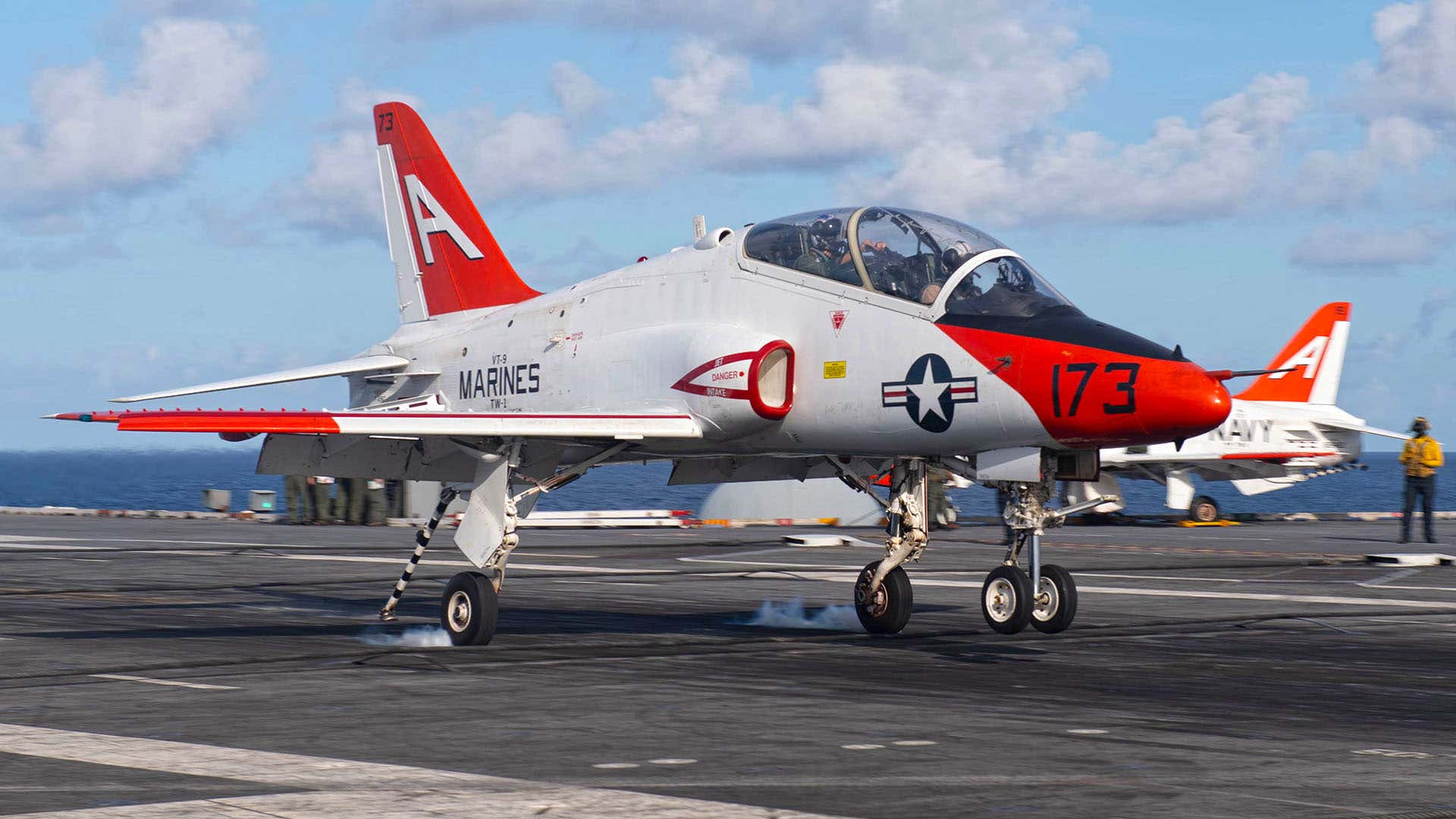
A T-45C student conducts carrier qualifications.
New trainer, new roles
Rear Admiral Harris says that as part of its future planning, the Navy is looking at how the new training aircraft could grow into other roles. He emphasizes how expensive it is to operate modern fighter aircraft, and that a surrogate aircraft could provide the Navy with a low-cost companion to its front-line fleet fighters, which could be a way to make the cost and sustainability of Naval aviation “more manageable.” He added that the Navy could then “turn that saving back into the enterprise for some of the more exotic capabilities.”
“I believe that in Naval aviation we’re probably looking at a platform that is multi-role. We’ve reached out to industry to see what is in the realm of possible, as much as finding a platform that we can do carrier aviation training with, but also may have the flexibility in that platform to be able to grow. Whether that’s similar to what the Air Force is looking at potentially with their [Boeing] T-7 or not, I don’t know.”
Notably, the USAF has from the outset eyed its new Boeing T-7A Red Hawk training aircraft with an in-house aggressor role in mind.
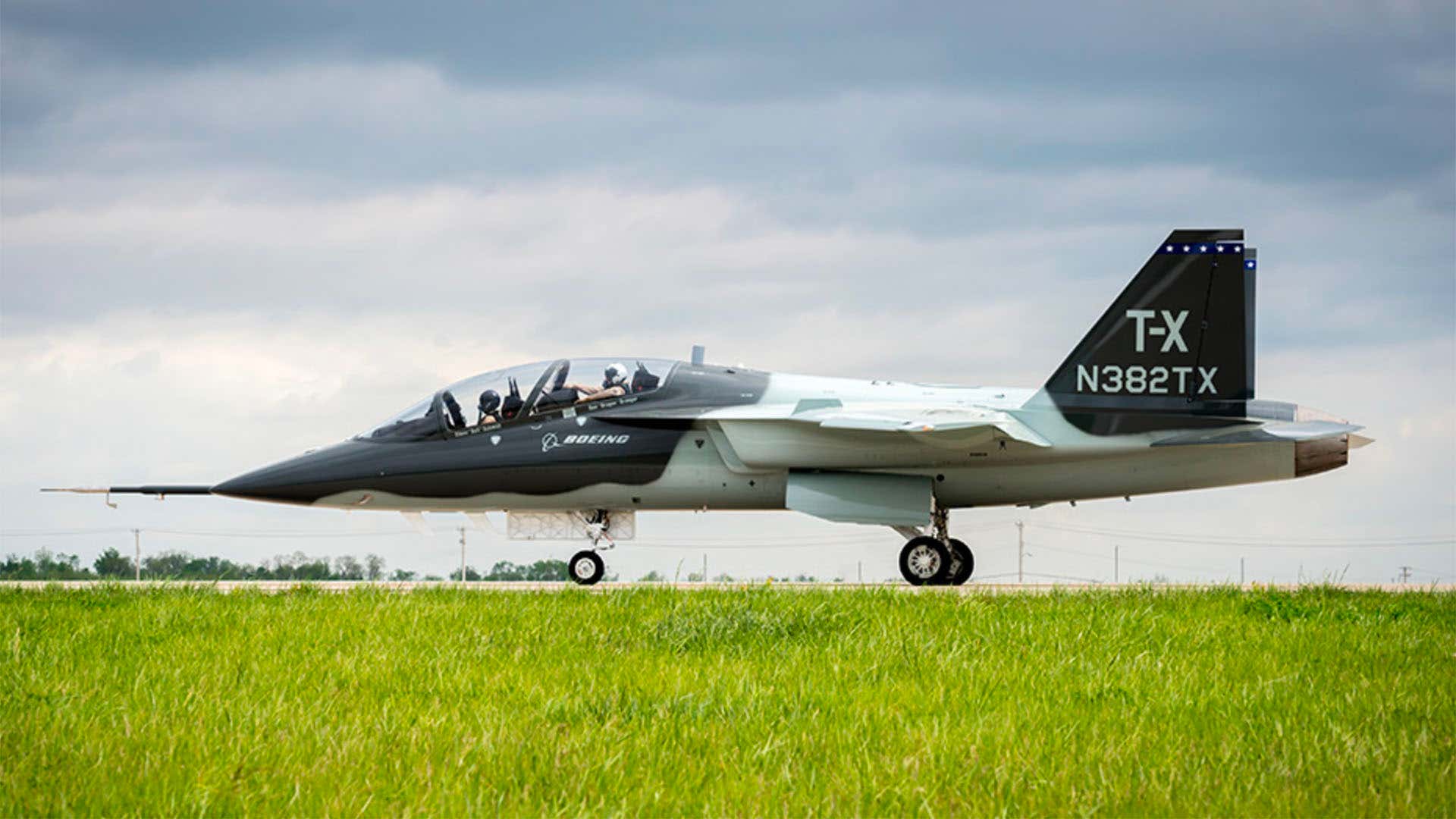
The Boeing T-7A Red Hawk.
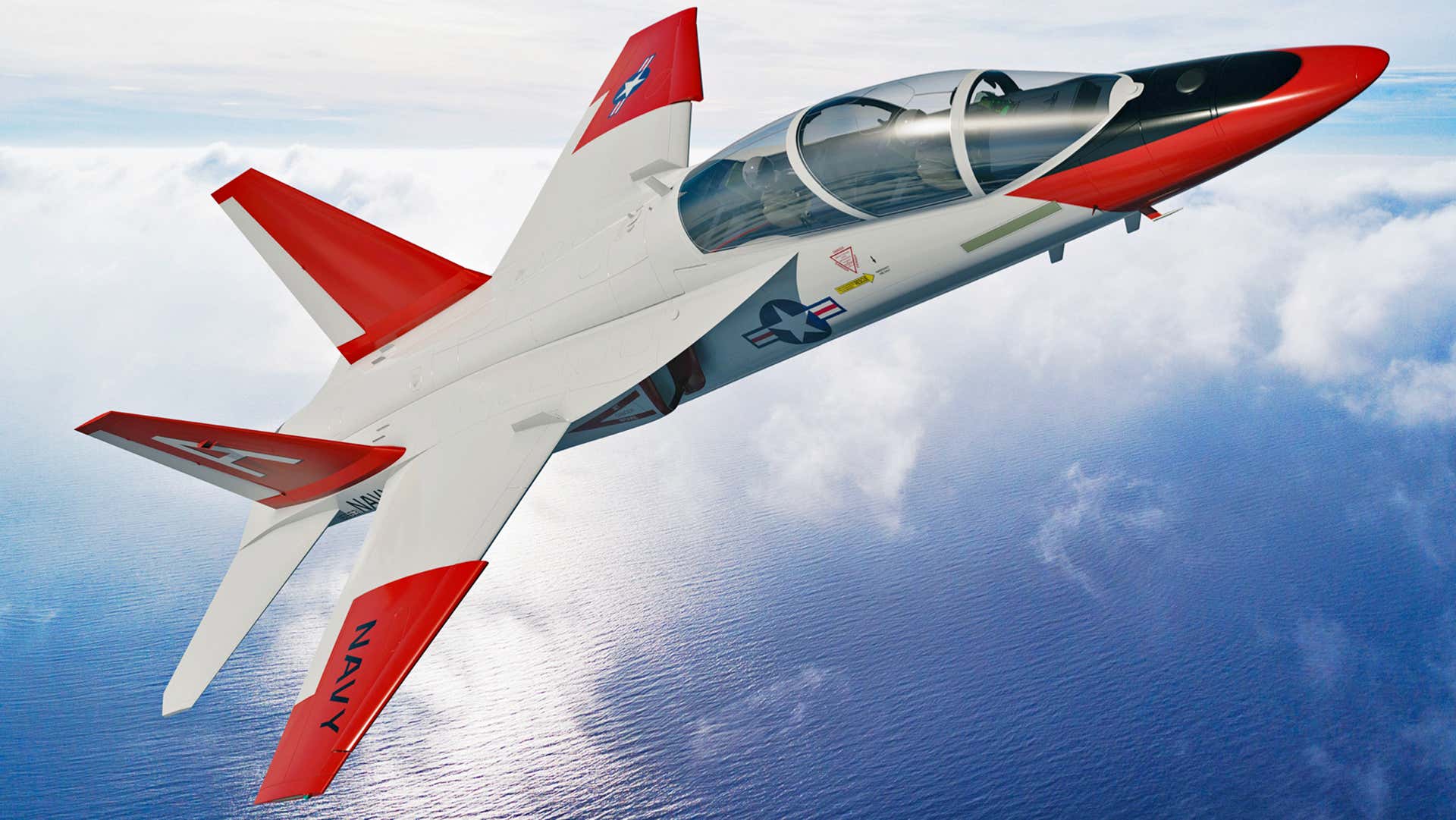
A rendering of a potential US Navy variant of the T-7.
“This training platform I believe is going to need to have growth to have a surrogate role — I mean it is relatively expensive to fly F-35 and I don’t believe it’ll be significantly less expensive to fly NGAD [Next-Generation Air Defense], or FA-XX, I don’t think it’s going to be less expensive to fly Super Hornets and Growlers in the future. So, if we can find a platform that we can use as a surrogate, not necessarily for everybody, but I might put my more senior folks in those on a formation hop or some role like that.”
The Navy is also looking at its organic adversary roles as a potential area where its new trainer could be employed. “We are trying to improve the capability of our adversaries,” explains Harris. “We’ve been flying the F-5s a significant amount of time and a few ‘Legacy’ Hornets. To provide that level of training, we’re going to be moving to F-16s to replace legacy Hornets, and then really working with our air force counterparts to see what else we can do from a surrogate aircraft that we may be able to use as an adversary.”
In a previous feature, The War Zone exclusively detailed how Fighter Squadron Composite 12 (VFC-12), the “Fighting Omars,” at Naval Air Station Oceana in Virginia, will trade its legacy Hornets for Super Hornets in 2021. The F-16 recapitalization plan is rumored to involve Strike Fighter Squadron 204 (VFA-204), the “River Rattlers,” which also flies aging F/A-18Cs, primarily in the adversary role. This is part of an overall move by the Navy to remove all legacy Hornets from the inventory in the coming year.
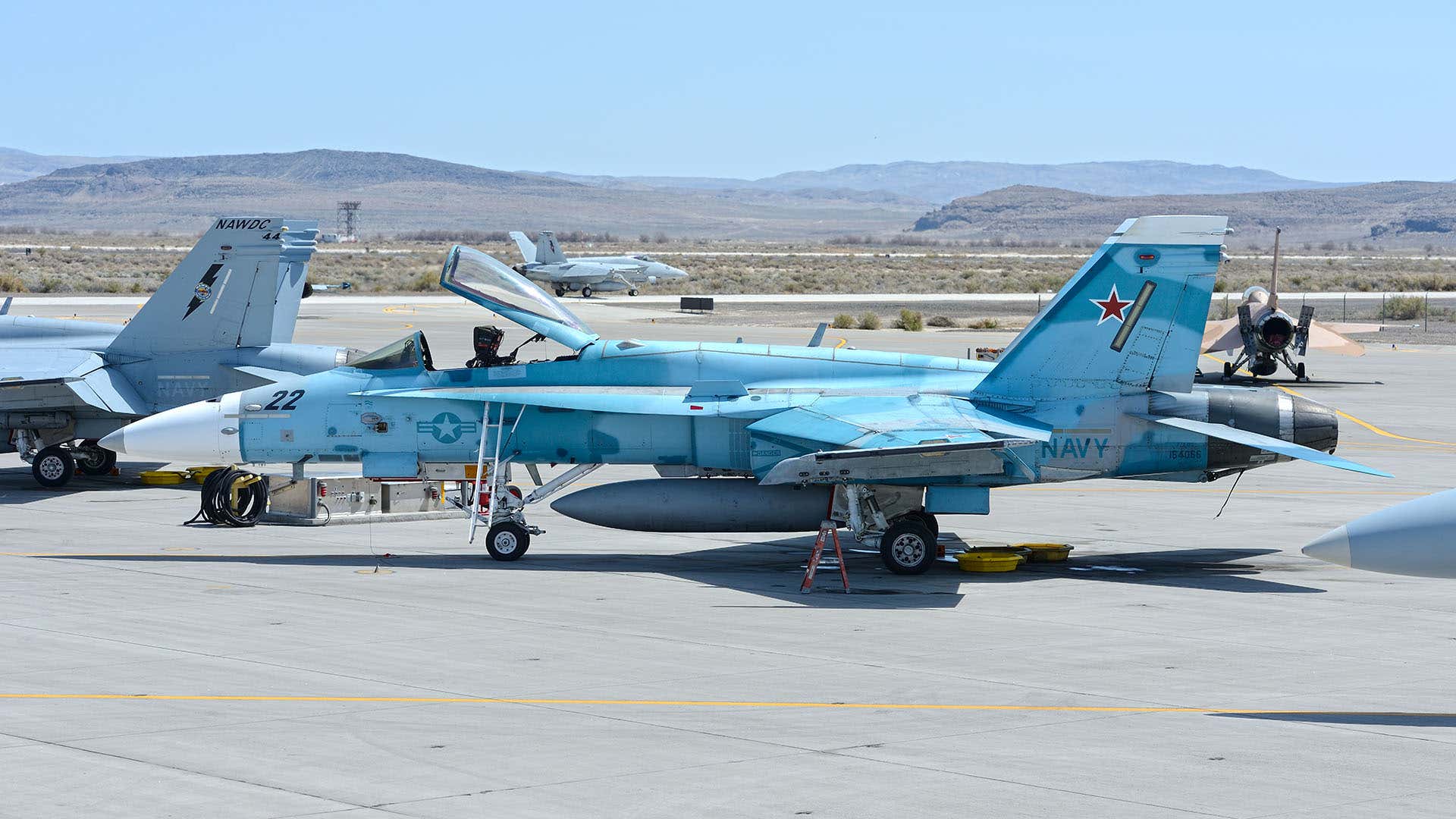
The Navy is looking to retire its remaining F/A-18C/Ds in 2021, and a new Navy trainer could become a replacement adversary aircraft.
Project Avenger
In addition to re-evaluating the carrier qualification component in the T-45 syllabus, CNATRA is overhauling core elements of the pilot training program. Project Avenger started earlier this year as part of a Pilot Training Next initiative, and its name pays homage to the rate at which the Navy was able to train 35,000 new pilots at the height of World War II. The USAF is deeply engaged in similar projects that are designed to drastically overhaul pilot training.
Named after the Grumman Avenger torpedo bomber of World War II fame, the Project Avenger initiative is about a new training philosophy using new technology to get new aviators trained in “18 months, street to fleet.” The aggressive timeline currently includes 20 students who are now in primary flight training. This first phase of the test period is expected to be complete early in 2021, before the students move to the T-45, and before joining a revamped strike fighter syllabus when they reach the FRS.
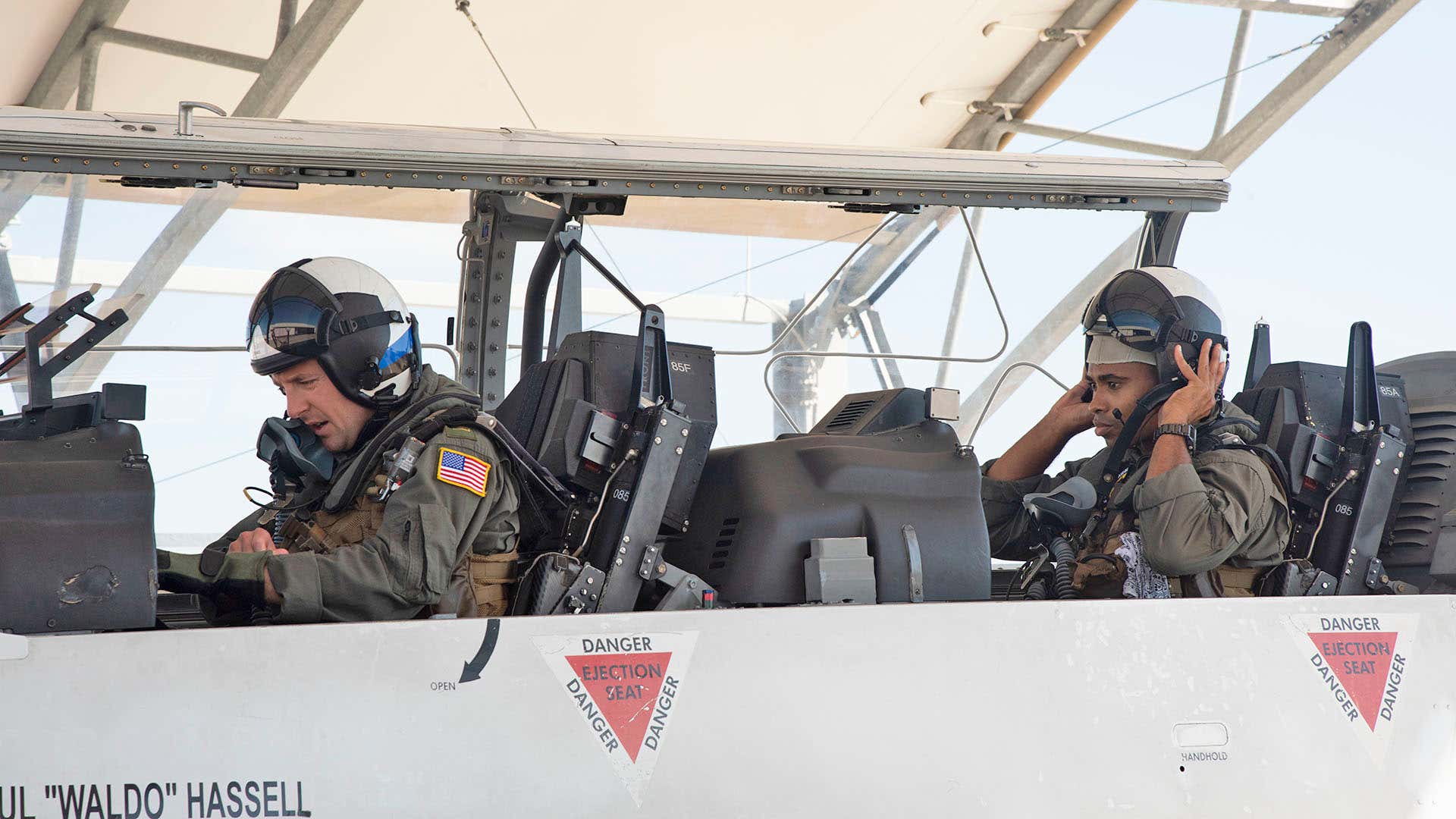
A student in the Project Avenger program prepares for a first flight in the T-6B in November 2020.
The Navy is replacing traditional paper publications with iPads for each student so they can enjoy on-demand access to courseware, with their learning planned to be enhanced through deep repetitions. A series of 360-degree recorded training videos are being used by the students, so they can see what their actual live flight mission events look like via virtual reality goggles, ahead of the event. This is aimed at accelerated learning, so that students can advance through the syllabus and develop advanced skill sets, which will enable them to perform better in simulators, and in the air.
The Navy is adamant that it is not cutting any flight hours, but that this will ultimately produce a better naval aviator, faster, thanks to increased efficiency. The use of Virtual Reality Part-Task Trainer systems are being rolled out first in the T-6B Texan II, and the Navy wants to repeat this in the follow-on advanced jet training syllabus. However, it acknowledges the move from the T-6 to the T-45 is currently something of a retrograde step in terms of advanced learning. The Navy’s new training aircraft will be aimed at addressing that requirement for advanced learning, with embedded, synthetic training being a vital component.
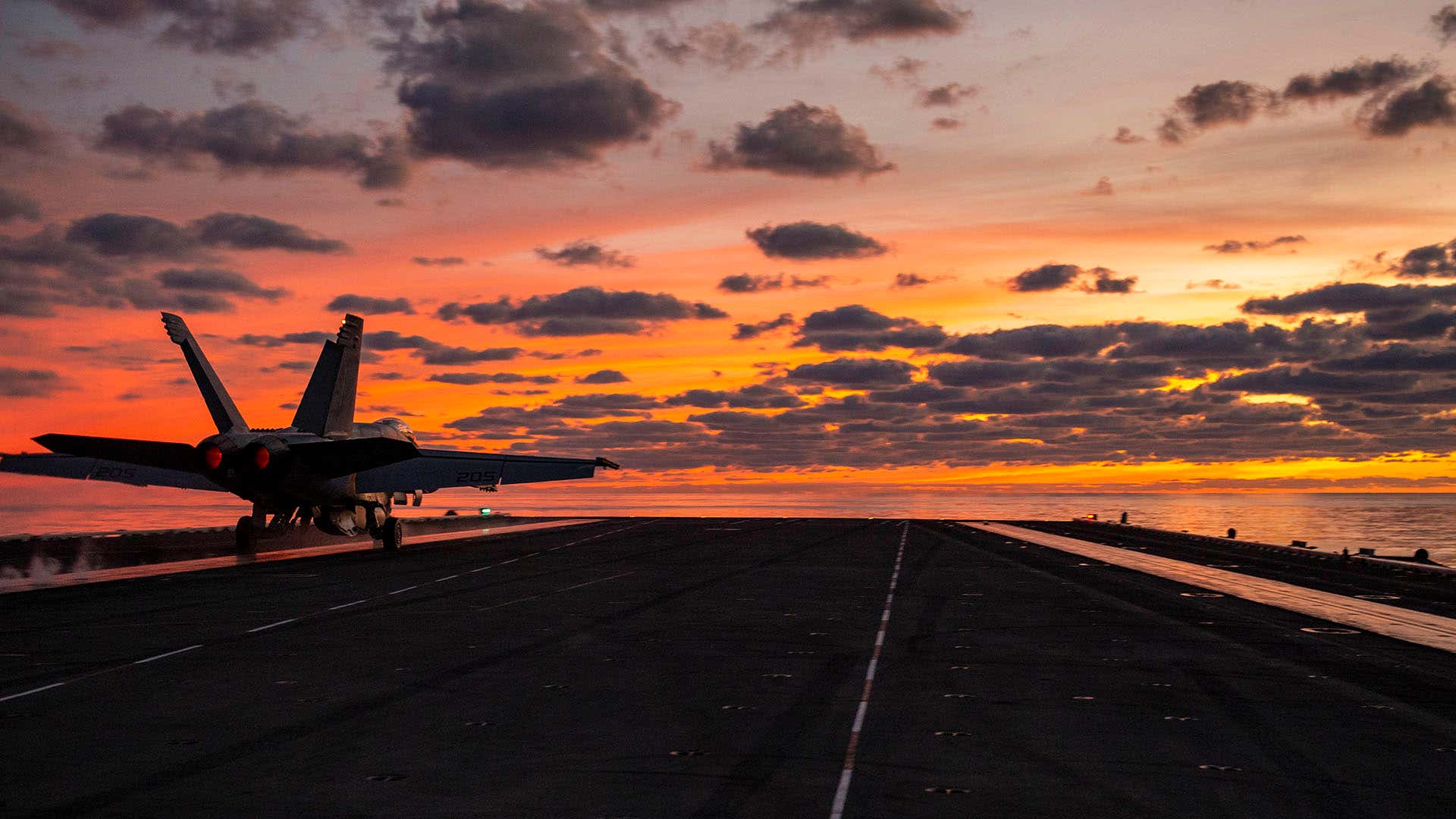
The Navy could be heading for a new dawn in carrier aviation training.
So, the Navy’s new jet trainer will not only address a dramatic push to evolve the way the service trains new aviators, but it seems the winning candidate will also need to be a high-performance multi-role type, so that it can become a companion trainer, as well as potentially being the Navy’s next adversary fighter as well. And, based on what we now know, it is very possible, if not probable, that this aircraft will never see a carrier deck.
An experienced U.S. Navy strike fighter pilot told The War Zone “The current [training] process is seen as a rite of passage in carrier aviation. That before carrier Naval Aviators are winged, they go to the boat solo — success or failure is up to the individual. The confidence gained during this process is immeasurable. The proposed new process will change something that has been in place for decades.”
“It’s easier to land on the boat with PLM or DFP, but it is not automatic. Carrier qualification is more than catching the wire. It is the exposure to the carrier environment and how an individual deals with it. The pattern, the communications, the nuance, the stress. The ability to master this is one of our competitive advantages.”
The War Zone reached out to the Navy Office of Information (CHINFO) regarding plans for the new jet training aircraft and received the following statement: “A final decision on the next training aircraft has not yet been made, so we cannot definitively say whether it will or will not be capable of shipboard operations at this time.”
Overall, these potential major changes to how many Naval Aviators are trained represents an ambitious set of goals, ones that will surely press Naval Aviation’s highly ingrained cultural norms, which are largely built around carrier flying, to the absolute limit. But if it works, it could set new benchmarks in the way advanced jet training aircraft are employed by modern air arms going forward and result in a more efficient era in U.S. naval aviation.
Related posts:
- When landing cable snapped on USS Eisenhower, Hawkeye pilots say years of training helped them save lives and the aircraft
- Navy conducts F-35C qualifications aboard aircraft carrier
- Navy to revive training squadron for Sea Dragon helicopter pilots and crew
- First Fleet F35-C Carrier Qualifications, Final Round of Testing Conducted at Sea
